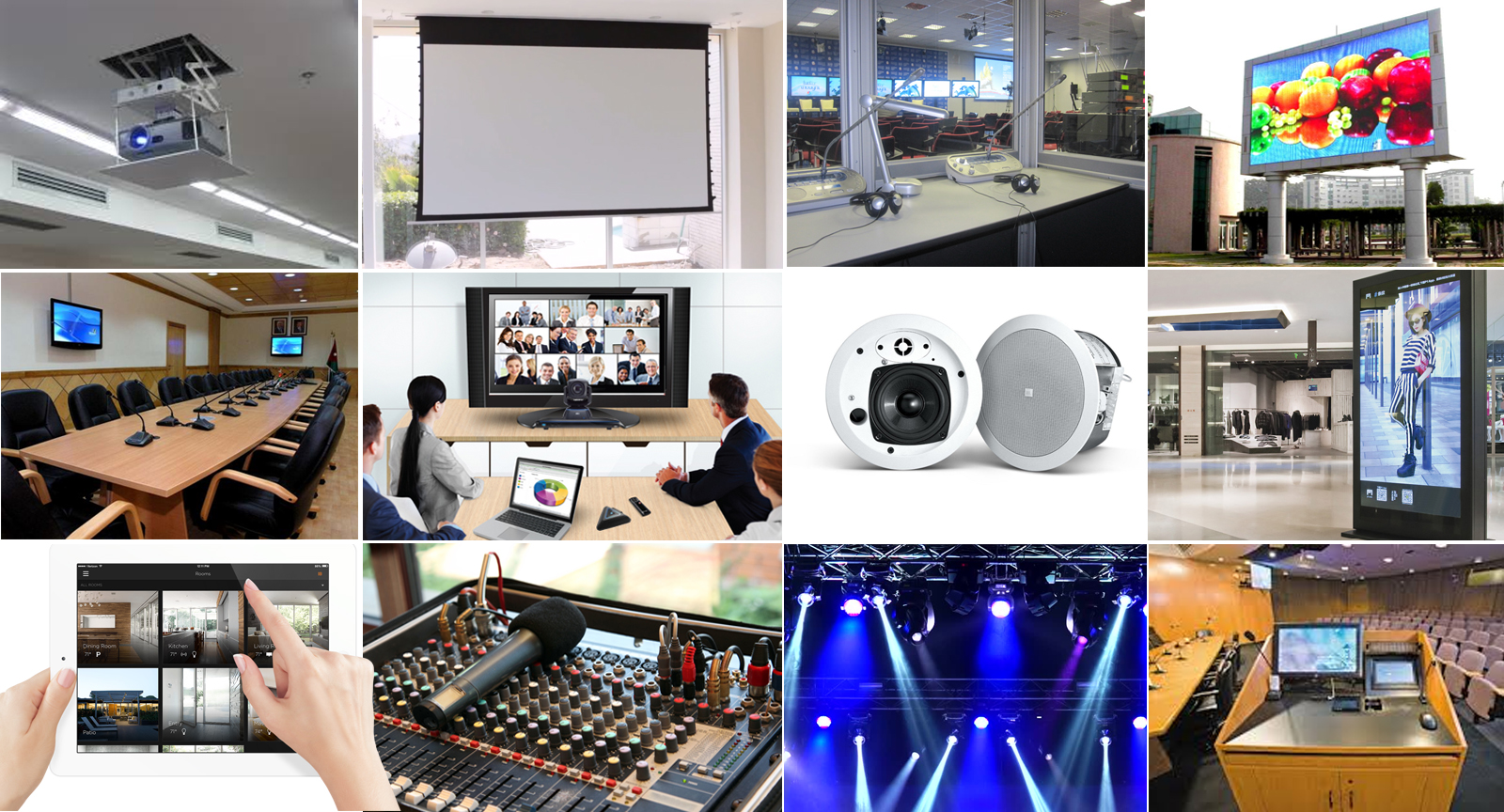Success stories showcasing audio visual charlotte nc in action
Understanding the Inclusion of Audio Visual Technology in Today's Educational Environments
The integration of audio-visual innovation in academic settings has actually transformed the training and discovering process. Educators currently have access to tools that cater to different learning designs, boosting student engagement and partnership. The consolidation of these innovations provides both possibilities and difficulties. Comprehending how to successfully implement these tools is crucial. What methods can teachers employ to take full advantage of the advantages of audio-visual modern technology in their classrooms?
The Advancement of Audio-Visual Innovation in Education And Learning
As educational requirements progressed over the years, audio-visual modern technology underwent substantial makeovers that reshaped the understanding environment. At first, tools such as movie projectors and slide programs were the primary methods of incorporating visual elements right into class. These early modern technologies offered teachers with the ability to existing details dynamically, yet they were limited in ease of access and interactivity.
With the advent of video clip cassette recorders in the 1970s, classrooms started to incorporate documented lessons, broadening the range of educational resources. The introduction of desktop computers in the 1980s more changed this landscape, permitting the development of multimedia presentations and interactive learning experiences.
The increase of the internet in the 1990s noted a crucial minute, allowing real-time accessibility to a wealth of audio-visual products. Today, digital tools such as interactive whiteboards and on-line understanding platforms remain to improve the academic experience, fostering involvement and cooperation amongst students.
Benefits of Audio-Visual Equipment for Diverse Knowing Styles
Audio-visual devices play a crucial function in catering to varied knowing styles by improving visual knowing and boosting auditory engagement. By including photos, video clips, and sound, these modern technologies develop an even more inclusive educational setting. This complex approach enables teachers to deal with the different choices and requirements of pupils efficiently.
Enhancing Visual Understanding
Engagement in the knowing process is considerably boosted via making use of audio-visual tools, catering to different learning designs. These devices, such as videos, infographics, and interactive presentations, supply aesthetic stimuli that aid comprehension and retention. Visual students, particularly, advantage from the unification of photos and computer animations, which can simplify intricate concepts and enhance understanding. In addition, audio-visual resources can highlight real-world applications, making discovering more relevant and engaging. By integrating shade, movement, and noise, educators can produce a dynamic learning environment that records pupils' focus and fosters deeper cognitive links. Inevitably, the critical use audio-visual innovation not only sustains aesthetic discovering but also enhances the total instructional experience for diverse learners.
Improving Auditory Engagement
A significant advantage of integrating audio-visual tools in education is their ability to enhance auditory engagement amongst students. These tools, which include multimedia discussions, podcasts, and interactive sound elements, deal with numerous learning styles, especially profiting acoustic learners (audio visual charlotte nc). By integrating noise and narrative, teachers can create immersive experiences that catch trainees' focus and strengthen understanding. This engagement is crucial, as it cultivates a much deeper understanding of the product and promotes retention. In addition, audio-visual devices can facilitate collaborative knowing atmospheres, motivating trainees to join discussions and share their understandings. Ultimately, the incorporation of audio-visual technology not only sustains acoustic interaction yet likewise improves the total instructional experience, making finding out more vibrant and reliable for all trainees
Enhancing Interaction Via Interactive Knowing

Additionally, gamification elements, such as tests and simulations, can enhance inspiration and retention, making finding out more delightful and effective. These techniques not only stimulate cognitive involvement but likewise cater to varied learning styles, guaranteeing that all pupils can participate meaningfully. Consequently, interactive understanding environments promote a sense of area and belonging, inevitably causing boosted academic results. Through the combination of audio aesthetic technology, instructors can transform typical classrooms into lively spaces where trainees grow and actively shape their educational trips.
Connecting Concept and Experiment Multimedia Resources
Multimedia sources function as a vital web link between academic principles and practical application in academic setups. By enhancing interaction, promoting collaborative learning experiences, and supporting diverse knowing designs, these devices create a more comprehensive and dynamic learning environment - audio visual charlotte nc. This method not only fosters much deeper understanding however additionally prepares students for real-world difficulties

Enhancing Interaction Via Multimedia
Involvement in instructional setups significantly enhances when teachers include multimedia sources into their training methods. Using video clips, podcasts, and interactive discussions improves the discovering experience, enabling trainees to connect with the material on multiple degrees. Multimedia resources deal with numerous finding out styles, offering visual, auditory, and kinesthetic stimulations that can hold pupils' interest more effectively than typical lecture approaches. Additionally, these resources can streamline complicated principles, making them a lot more easily accessible and unforgettable. By integrating multimedia, teachers can create a vibrant classroom atmosphere that fosters inquisitiveness and inspires students. Ultimately, the critical use of audio-visual modern technology serves to connect the void between academic understanding and functional application, enriching the academic experience for both teachers and pupils.
Assisting In Collaborative Knowing Knowledge
Many studies indicate that joint knowing experiences significantly boost trainee end results when incorporated with multimedia resources. Multimedia tools promote communication among pupils, permitting them to take part in analytical and important assuming collectively. By utilizing video clip conferencing, collaborative systems, and interactive presentations, teachers produce atmospheres conducive to synergy and shared knowing. These innovations make it possible for get more info students to communicate their concepts efficiently and obtain immediate feedback, fostering a deeper understanding of the subject issue. In enhancement, multimedia sources can present complex ideas in even more absorbable styles, advertising conversation and cooperation. Consequently, the mix of joint learning and audio-visual technology not just improves the instructional experience however likewise prepares pupils for real-world synergy dynamics, stressing the importance of teamwork and cumulative expertise building and construction.
Sustaining Diverse Learning Styles
While typical training approaches often accommodate a minimal series of discovering choices, the integration of audio-visual technology supplies a much more inclusive approach to education and learning. By employing multimedia sources such as video clips, interactive simulations, and electronic presentations, educators can address numerous discovering styles, including visual, auditory, and kinesthetic. This flexibility enables differentiated guideline, allowing students to involve with material in methods that resonate with their specific choices. Furthermore, audio-visual tools can help with much deeper understanding by supplying numerous depictions of complex ideas. Consequently, trainees that may deal with traditional techniques can discover alternate paths to success, promoting a much more equitable understanding environment that supports scholastic success for all learners.
Difficulties in Implementing Audio-Visual Modern Technology
Although audio-visual modern technology holds excellent pledge for enhancing academic experiences, its application often encounters substantial challenges. One primary concern is the financial concern related to purchasing and preserving such devices, which can stress spending plans, particularly in underfunded institutions. Furthermore, insufficient training for teachers can impede reliable assimilation, leaving them ill-prepared to make use of the technology fully. Technical issues, such as software program malfunctions and compatibility problems, may also interrupt lessons and annoy both instructors and trainees. Varying levels of pupil accessibility to innovation outside the class can produce differences in learning opportunities. The capacity for over-reliance on modern technology might take away from vital mentor methods, ultimately restricting the academic experience. Attending to these challenges needs a complete technique, including ample financing, expert development, and fair accessibility to resources, to guarantee that audio-visual modern technology can be leveraged successfully in today's educational setups.
Best Practices for Integrating Modern Technology in the Classroom

In addition, fostering an interactive environment with collective devices urges pupil engagement and participation. Utilizing diverse audio-visual sources caters to various discovering designs, accommodating visual, auditory, and kinesthetic learners. Frequently assessing the impact of technology on pupil learning helps teachers fine-tune their techniques and adapt to altering needs. Finally, involving students in the choice of technology advertises possession and motivation. By adhering to these best techniques, teachers can produce a dynamic class atmosphere that effectively incorporates modern technology and improves the academic experience for all students.
The Future of Audio-Visual Modern Technology in Education
As classrooms progressively welcome innovation, the landscape of audio-visual tools in education and learning remains to evolve (audio visual charlotte nc). Future advancements are expected to focus on better interactivity and personalization, permitting educators to customize learning experiences to specific pupil needs. Developments such as increased truth (AR) and online truth (VIRTUAL REALITY) will likely give immersive learning environments, improving pupil interaction and understanding
Additionally, expert system (AI) is poised to play a considerable duty in audio-visual innovation by providing real-time comments and flexible knowing paths. This integration might help instructors identify and address student difficulties better. Cloud-based platforms will facilitate simpler accessibility to sources and cooperation among trainees and teachers, regardless of location.
In enhancement to these technical breakthroughs, expert development for instructors will certainly be vital, ensuring they are furnished to utilize these devices efficiently. Overall, the future of audio-visual modern technology in education promises to produce more dynamic, inclusive, and impactful discovering experiences.
Often Asked Concerns
Just How Can Educators Choose the Right Audio-Visual Devices for Their Class?
Selecting ideal audio-visual tools requires teachers to assess their academic goals, think about trainee demands, examine offered innovation, and seek suggestions from peers or specialists, ensuring devices properly boost understanding and involvement within their details class atmosphere.
What Spending plan Factors to consider Are There for Carrying Out Audio-Visual Innovation?
Budget plan considerations for applying audio-visual modern technology include initial purchase expenses, maintenance expenses, training for team, and prospective software licensing costs. Furthermore, long-term financial investment in updates and replacements should additionally be factored into economic planning.
Exist Details Training Resources for Educators on Audio-Visual Tools?
Several establishments use training sources for instructors on audio-visual tools, consisting of online programs, workshops, and educational overviews. These resources intend to improve educators' abilities and confidence in successfully incorporating modern technology into their teaching methods.
How Do We Determine the Efficiency of Audio-Visual Modern Technology in Learning?
Measuring the effectiveness of audio-visual modern technology in finding out entails evaluating pupil interaction, comprehension, retention prices, and overall academic efficiency. Studies, assessments, and observational researches can provide important understandings into its influence on educational end results.
What Prevail False Impressions Regarding Audio-Visual Modern Technology in Education?
Typical false impressions regarding audio-visual innovation in education and learning consist of the idea that it guarantees engagement and finding out results, along with the presumption that all pupils benefit similarly, forgeting specific knowing choices and demands.